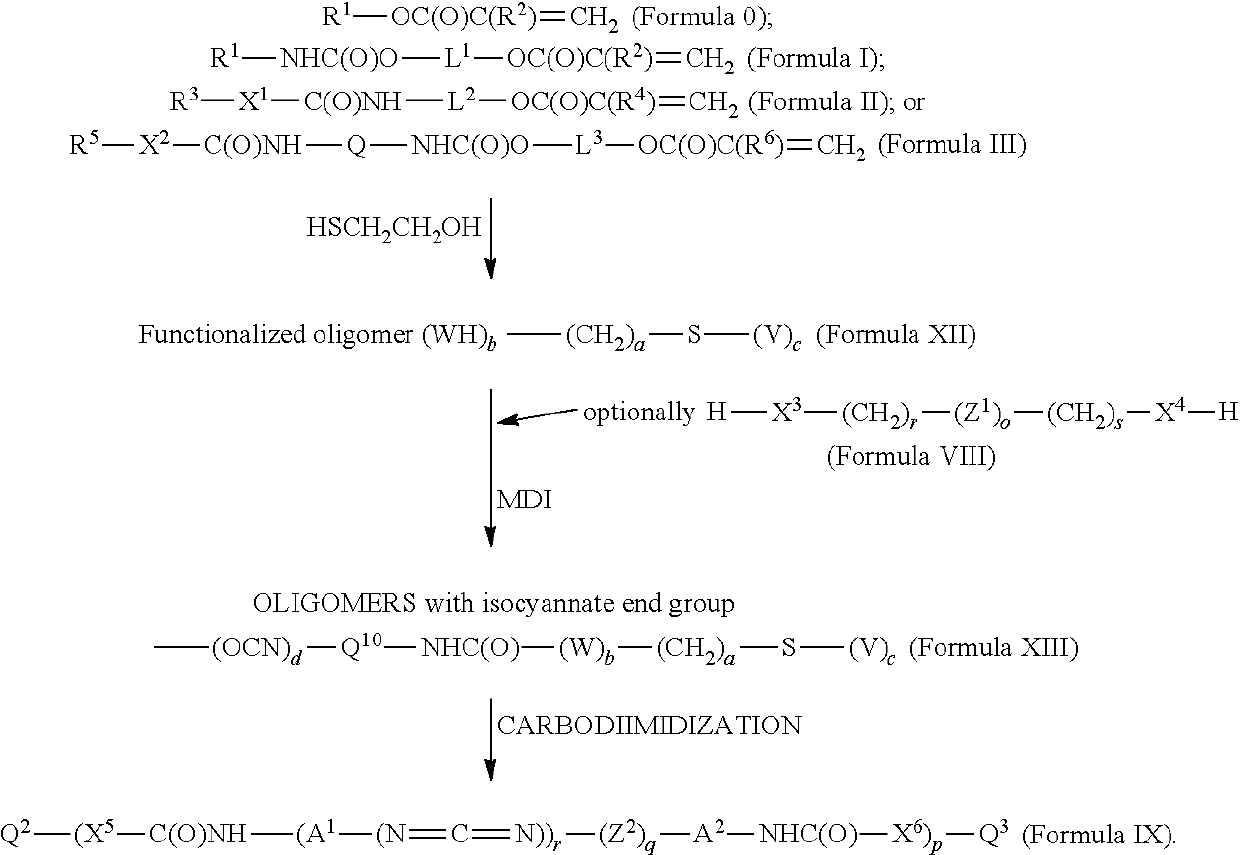Fluorine-free fibrous treating compositions, treated substrates, and treating methods
a technology of fibrous treatment composition and fluorine-free fibrous, which is applied in the direction of liquid repellent fibres, papermaking, coatings, etc., can solve the problems of fluorinated treatment agents, their production price, and potential environmental concerns, and achieve high initial water repellency properties, high water repellency properties, and high durability. the effect of the repellency
- Summary
- Abstract
- Description
- Claims
- Application Information
AI Technical Summary
Benefits of technology
Problems solved by technology
Method used
Image
Examples
examples
Preparation of (Meth)Acrylate Monomers
SI-HOEA Made from Stearyl Isocyanate and 2-Hydroxyethyl Acrylate
[0482]In a 1-liter round-bottomed 3-necked reaction flask, 295.5 g of stearyl isocyanate (SI) (1 mole) was mixed with 116 g of 2-hydroxyethyl acrylate (HOEA) (1 mole). At room temperature a clear solution was obtained. The reaction quickly started after the addition of 5 drops of DBTDL, the temperature of the reaction mixture spontaneously increased, and a white insoluble material started to form in the mixture. Temperature was raised to 80° C. and the reaction was continued for 3 hours (hrs) at 80° C. After this period, the FTIR (Fourier Transform Infrared) spectrum showed all NCO disappeared. The structure of the final material was confirmed by NMR (Nuclear Magnetic Resonance) to be C18H37NHC(O)OCH2CH2OC(O)CH═CH2, which is Formula Ia. At room temperature a hard solid waxy material was obtained, referenced as “SI-HOEA.”
SA-AOI Made from Stearyl Alcohol (SA) and Isocyanato Ethylacryl...
examples 1 to 15 (
EX1 to EX15), Reference Examples REF1 to REF9
[0697]The water-based polymer dispersions of Examples 1 to 15, Reference Examples REF 1 to REF 9 as indicated in table 1, were applied to PES and PA fabrics according to the general procedure “Treatment Procedure via Padding Process, Water-based Dispersions” as given above. The treated samples were not ironed after tumble dry.
[0698]The treated fabrics were tested for their dynamic water repellent properties according to the “Spray Rating (SR)” test outlined above. The properties were tested initially and after 10 or 20 launderings. After the 10 or 20 washing cycles the textile samples were dried in a Miele T-356 tumble drier, setting ‘Extra dry’. The samples were not ironed. The samples were conditioned overnight at room temperature before testing. The results of spray rating were indicated as SR IN (initial) and SR 10L and SR 20L respectively. The treated fabrics of Examples 12 and 13 and Reference Examples REF1 and REF9 were subjected t...
examples 16 to 20 (
EX16 to EX20) and Reference Examples REF 10 to REF 13
[0700]The water-based polymer dispersions of Examples EX16 to EX20 and Reference Examples REF 10 to REF 13 having compositions as listed in Table 3, were applied to PES and PA fabrics according to the general procedure “Treatment Procedure via Padding Process, Water-based Dispersions” as given above.
[0701]The treated fabrics were tested for their dynamic water repellent properties according to the “Spray Rating (SR)” test outlined above. The properties were tested initially and after 10 or 20 launderings. After the 10 or 20 washing cycles the textile samples were dried in a Miele T-356 tumble drier, setting ‘Extra dry’ and ironed at 180° C. during 3 seconds. The samples were conditioned overnight at room temperature before testing. The results of spray rating were indicated as SR IN, SR 10L IR, and SR 20L IR, respectively. The results are recorded in Table 3.
TABLE 3Spray Ratings (0.6% SOF); Water-based Dispersions(PES: 76.4% WPU; ...
PUM
| Property | Measurement | Unit |
|---|---|---|
| weight average molecular weight | aaaaa | aaaaa |
| weight average molecular weight | aaaaa | aaaaa |
| weight average molecular weight | aaaaa | aaaaa |
Abstract
Description
Claims
Application Information
 Login to View More
Login to View More - R&D
- Intellectual Property
- Life Sciences
- Materials
- Tech Scout
- Unparalleled Data Quality
- Higher Quality Content
- 60% Fewer Hallucinations
Browse by: Latest US Patents, China's latest patents, Technical Efficacy Thesaurus, Application Domain, Technology Topic, Popular Technical Reports.
© 2025 PatSnap. All rights reserved.Legal|Privacy policy|Modern Slavery Act Transparency Statement|Sitemap|About US| Contact US: help@patsnap.com

